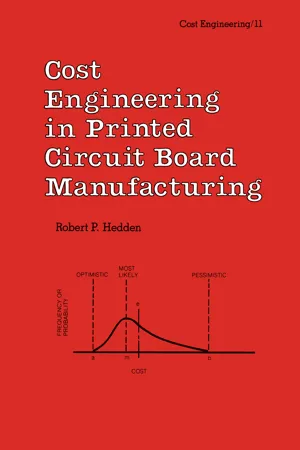Cost Calculation
Cost calculation refers to the process of determining the expenses associated with a particular project, product, or service. It involves analyzing various cost factors such as materials, labor, overhead, and other expenses to arrive at the total cost. This calculation is essential for budgeting, pricing, and decision-making within the technology and engineering sectors.
4 Key excerpts on "Cost Calculation"
- eBook - ePub
- K. L. Richards(Author)
- 2020(Publication Date)
- CRC Press(Publisher)
...10 Engineering Design Economics 10.1 Project/Design Cost Accounting 10.1.1 Project/Design Cost Estimating Cost estimating is the practice of forecasting the cost of completing a project with a defined scope. It is the primary element of project cost management, a knowledge area that involves planning, monitoring and controlling a project’s monetary costs. (Project cost management has been practiced since the 1950s.) The approximate total project cost, called the cost estimate, is used to authorise a project’s budget and manage its costs. An accurate cost estimate is critical for deciding whether to take on a project for determining a project’s eventual scope, and for ensuring that projects remain financially feasible and avoid cost overruns. Cost estimates are typically revised and updated as the project’s scope becomes more precise and as project risks are realised, cost estimating is an iterative process. A cost estimate may also be used to prepare a project cost baseline, which is the milestone-based point of comparison for assessing a project’s actual cost performance. 10.1.2 Key Components of a Cost Estimate A cost estimate is a summation of all the costs involved in successfully finishing a project, from inception to completion (project duration). These project costs can be categorised in a number of ways and levels of detail, but the simplest classification divides costs into two main categories: direct costs and indirect costs. 10.1.2.1 Direct Costs Direct costs are broadly classified as those directly associated with a single area (such as a department or a project). In project management, direct costs are expenses billed exclusively to a specific project...
- Sherif D. El Wakil(Author)
- 2019(Publication Date)
- CRC Press(Publisher)
...Here is the general equation: C = C 0 ∑ i = 1 i = n P i m i (2.7) where C is the cost C 0 is a constant P i is the parameter i affecting the cost m i is a constant exponent for parameter i C 0, P i, and m i are determined by mathematical and statistical methods. Although the formula is limited in scope to the specific equipment or system for which it is developed, it has proven to be very useful in cost models because it elaborates the elements and parameters that contribute most to the cost. It also leads to the ability to minimize and optimize cost using simple mathematical manipulations such as those of differential calculus. 2.6 Engineering Cost Engineering cost includes salaries for high-level engineering jobs as well as expenditures (whether salaries or general expenses) for R&D. Usually, the engineering cost for a product is considered part of the factory overheads (or even part of the corporate overheads in some cases). Nevertheless, it is sometimes estimated separately based on previous records of existing similar products. In some cases (especially when the product is supplied to the federal government), a firm is hired to do the engineering on a contractual basis. The contract may specify a lump sum for the engineering cost or may involve the true engineering cost plus a negotiated fee or profit of, say, 15 percent of the cost. In this latter case, the engineering cost must be accurately determined. 2.7 Overhead Cost Overhead costs are usually viewed by cost engineers as a burden because such costs cannot be directly or specifically related to the manufacturing of any particular product or even to a particular category of the company’s production. Overhead costs can be divided into two main groups: factory overheads and corporate overheads. 2.7.1 Factory Overheads Factory overheads include the previously mentioned engineering costs as well as other factory expenses that are not related to direct labor or material...
- R. P. Hedden(Author)
- 2020(Publication Date)
- CRC Press(Publisher)
...7 Estimating Engineering and Other Expenses The cost of engineering support for the printed circuit board and electronics industry has been mentioned as significantly larger than in most other industries. It has been said that the three major elements of cost in most manufacturing processes are labor, overhead, and material. Typically, engineering is included in overhead, but in the electronics industry it is usually separately estimated, tracked, and managed as the fourth element of cost because of its magnitude. Engineering expense includes the effort to develop and then support manufacturing processes through the life of the product. Although the cost of designing and developing new products is an engineering expense, it is excluded from this discussion and is considered part of research and development. However, the principles discussed here may also be applied to research and development expense estimating. The various activities included in engineering expense are the design and debugging of tooling and equipment for the manufacturing processes, scaleup activities for volume increases, writing process specifications, and so on. Engineering is also responsible for estimating the cost to design and build tooling and equipment and for estimating the costs of materials used in the product and the processes required to build the product. Figure 1.2 illustrated a form for the recording of manufacturing operation information. On that form is space for the inclusion of design, building and debugging cost, and installation cost for equipment associated with the operation. Estimating these costs, along with the related process design cost and material costs, is the subject of this chapter. In a new technology estimate it is usually necessary to estimate overhead rates. A major cost element in overhead is equipment depreciation. The capitalized cost, which is depreciated, generally consists of the design, building, and debugging cost...
- eBook - ePub
- Bijan Vasigh, Javad Gorjidooz(Authors)
- 2016(Publication Date)
- Routledge(Publisher)
...Five years of continued production resulted in that time in the final assembly for a single aircraft dropping to as low as around 50 days. Estimating Costs Engineering economic analysis involves the consideration of present and future economic factors. Hence, it is critical to obtain reliable estimates of future costs, benefits, and other economic parameters. A characteristic of cost estimates is that errors in estimating are typically asymmetric as costs are more likely to be underestimated than overestimated. The development of cost estimates involves certain difficulties or uncertainties arising from factors such as resource availability and estimator expertise. The quality of a cost estimate increases as the resources allocated to developing the estimate increase. However, the benefits expected from improving a cost estimate should outweigh the cost of devoting additional resources to the estimate improvement. A good example of cost estimation is the use of the Cobb–Douglas production function to determine the total production cost for a particular project. The Cobb–Douglas production function relates the total cost to the labor cost and the cost of capital to the total cost of production with the use of a productivity factor (Houthakker, 1955). TC = A L α K β Where: TC = Total cost of production A = Productivity factor L = Labor input (number of hours) K = Capital input α, β = Output elasticities of labor and capital For example, if α = 0.80, a 1 percent increase in labor usage would lead to approximately a 0.80 percent increase in total cost...



